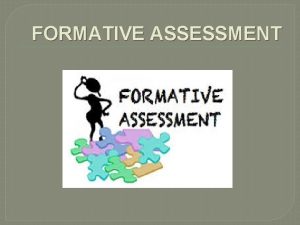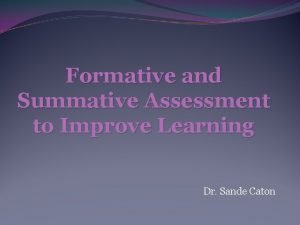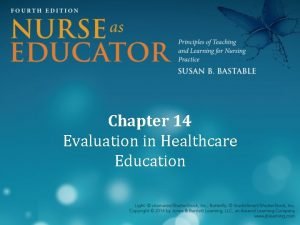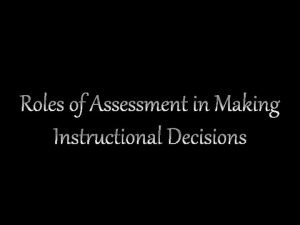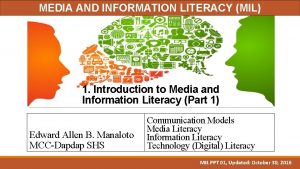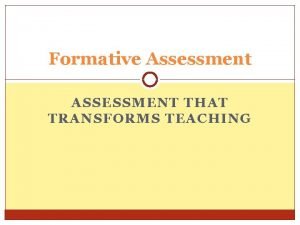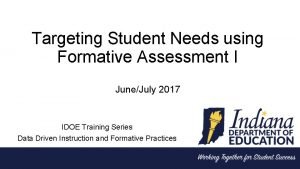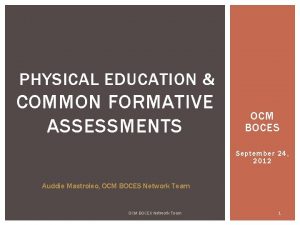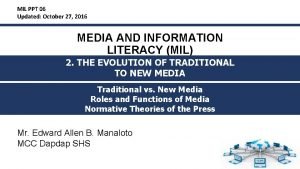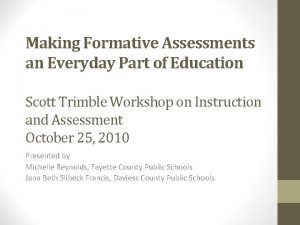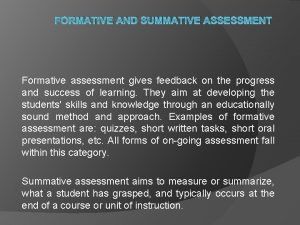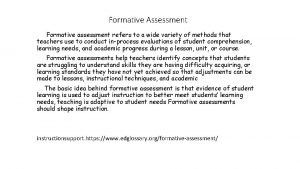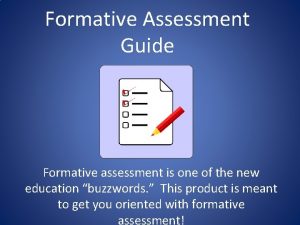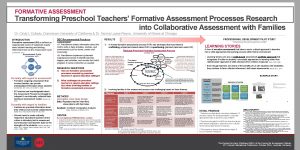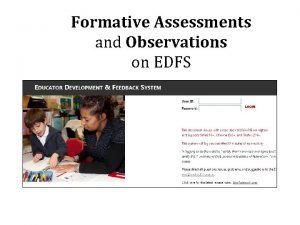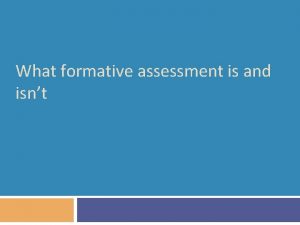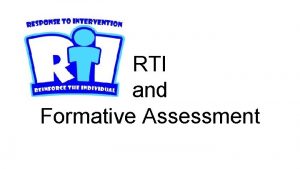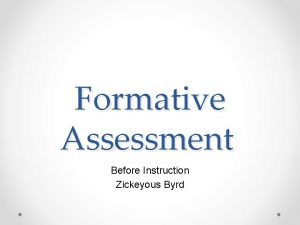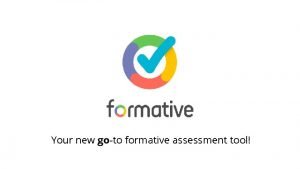Curriculum and Assessment Overview StateDistrict Standards Formative Assessment












- Slides: 12

Curriculum and Assessment Overview State/District Standards Formative Assessment with Performance Rubrics Differentiated Instruction RTI

Curriculum coming together with Assessment Remember, the goal of standards based curriculum is to: IMPROVE STUDENT ACHIEVEMENT by TEACHING LESS BETTER!!! By having an aligned curriculum and assessment program, teachers have a more defined idea of the content for which they are responsible. They can monitor student progress more effectively and are accountable for instruction and student growth. State/District Standards Formative Assessment with Performance Rubrics Differentiated Instruction RTI

A Principal’s Role in Curriculum • • • Knowledge of the Big Picture Knowledge of the Resources Facilitator of Implementation Responsible for Accountability Instructional Practices Innovator

Knowledge of the Big Picture State Standards National Standards Consortium or District Standards Need to the know the “big picture” but don’t need to be experts in every field. Have a good feel for what proficiency looks like in each grade level. • Need to be able to weed out “need to know” vs. “nice to know” to help teachers plan efficiently • •

State Curriculum Standards Cycle


OPI’s Content Standard Informer Sign up on OPI’s Curriculum and Assessment website Curriculum and Instruction Unit August 2010 Phase 2, Pilot Online Formative Assessment Writing Program The Office of Public Instruction (OPI) is launching Phase 2 of a pilot online formative assessment. The purpose of this pilot is to gain further experience with a formative assessment writing program, Vantage Learning’s My Access. This product was chosen from a group of four writing programs used in Montana classrooms as Phase 1 of the online formative assessment writing program in the 2009 -10 school year. The OPI invites you to apply to use My Access in your classroom as part of Phase 2 of the pilot. For more information and the application: http: //www. opi. mt. gov/PDF/Assessment/MCPresents/FAME/10 Application. pdf Professional Development Opportunities-Communication Arts Northwest Montana’s Reading Council’s Annual Literacy Conference, August 18, 2010, Flathead High School, Kalispell, Montana. For more information and a registration form please contact Northwest Reading Council, c/o Megan Koppes, 103 Getty Drive, Kalispell, MT 59901. Common Core State Standards (CCSS) Update Thirty states have adopted. Montana is following a plan and you can help. Montana will be conducting an alignment study that involves out-of-state experts completing a comparison of the CCSS and Montana Standards and Essential Learning Expectations, completing a comparison using Achieve’s Gap Analysis Tool; and looking at a comparison using the CCSSO Survey of Enacted Curriculum Tool. This alignment study will help determine the next steps. What can you do? • Examine the documents http: //www. corestandards. org/ • Watch the online presentation http: //connect. opi. mt. gov/p 16363458/ and keep checking for updates. • Give us your views by completing a survey about the CCSS (found in two locations): http: //www. opi. mt. gov/Curriculum/Comm. Arts/index. html http: //www. opi. mt. gov/curriculum/math/ • Join the team that will meet at the Montana Learning Center, August 11 -13, to complete the comparison using Achieve’s Gap Analysis Tool as well as determine what and how the 15 percent possible addition to the CCSS will look like. Sign up TODAY for the August 11 -13, CCSS Team; contact Kris Goyins, kgoyins@mt. gov or Jean Howard, jhoward@mt. gov

OPI Curriculum Specialists Kris Goyins Communication Arts Curriculum Specialist kgoyins@mt. gov Jean Howard Mathematics Curriculum Specialist jhoward@mt. gov Katie Burke Science Curriculum Specialist kburke@mt. gov Michael Hall Curriculum and Instruction Unit Manager/Technology Curriculum Specialist mhall@mt. gov Colet Bartow Library Media Curriculum Specialist cbartow@mt. gov Gifted and Talented Specialist Deb Poole dpoole@mt. gov

Knowledge of the Resources • Most important resource is PEOPLE – Find out who to ask at the state, district, and building level and DON’T be afraid to ask questions. BE REAL. – Identify the teachers who are doing the best job of raising achievement and use them as resources. • Survey your building to understand the resource materials available or not – Identify weaknesses in resources – Research how materials are adopted – Support teachers with getting what they need to teach efficiently and effectively—don’t hamstring them by expecting superior teaching without sufficient resources

Facilitator of Implementation • Principals have the power to drive school improvement. – Target areas where there is buy in first in order to build trust – Don’t try to implement everything at once – It will ALWAYS take much longer than anticipated. – Plan extended staff development to insure success. • Best staff development contains combines content knowledge and instructional methods. • Make follow up an integral part of staff development.

Responsible for Accountability • Pair Curriculum with Assessment • Create a culture of high expectations for students and staff – Go slowly in order to build trust • Identify and target effective instructional strategies to help teachers set goals. – Celebrate growth with teachers – Give teachers opportunities to learn and grow – Identify those teachers who can change and work with them to change. If they cannot change, work to change their situation. • Use your building/district evaluation tool to help implement curriculum and school improvement changes

Instructional Practices Innovator • Model good instructional/learning practice at faculty meetings, staff development, and your own professional growth. • Principals cannot delegate the tasks of creating the vision and maintaining the focus. They must perform the vital function of communicating the school’s goals to teachers, students, parents and the community. • Management tasks can be delegated. Gene Bottoms
 Venn diagram of media information and technology literacy
Venn diagram of media information and technology literacy Formativa
Formativa Penilaian formatif
Penilaian formatif Evaluation in healthcare education
Evaluation in healthcare education Diagnostic summative and formative assessment
Diagnostic summative and formative assessment Formative assessment analyze and explain this illustration
Formative assessment analyze and explain this illustration Summative and formative assessment
Summative and formative assessment Formative assessment process
Formative assessment process Common formative assessment examples
Common formative assessment examples Mil ppt
Mil ppt Venn diagram of people as media and people in media
Venn diagram of people as media and people in media Kwl formative assessment
Kwl formative assessment Facets of formative assessment
Facets of formative assessment

